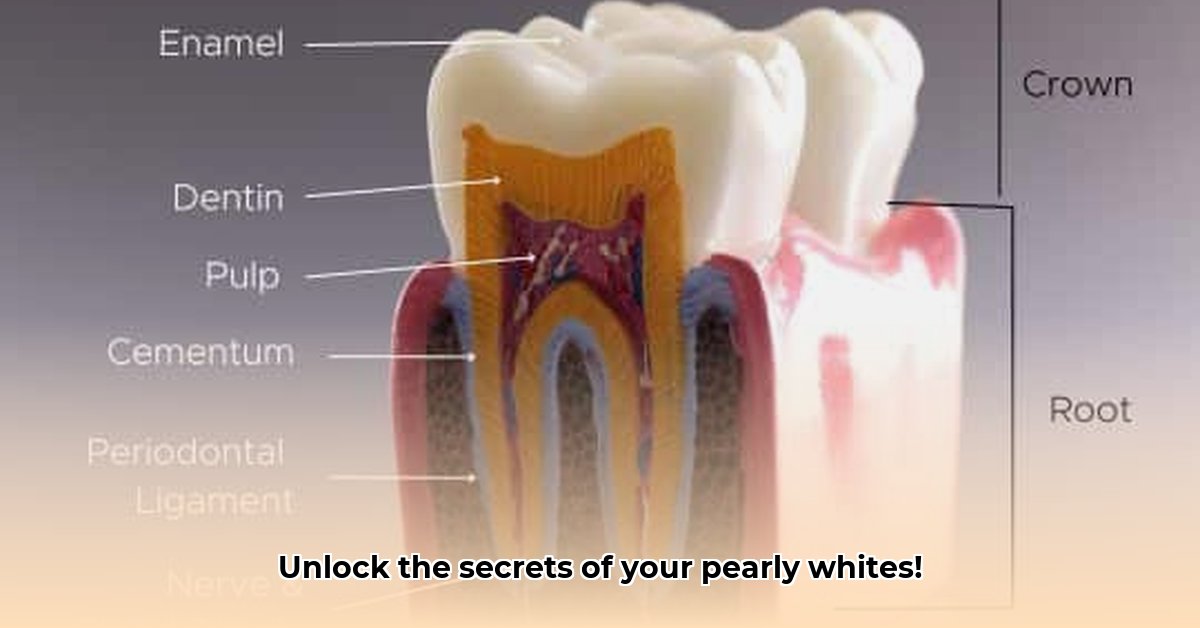Ever wondered about the intricate composition of your teeth? They’re not just solid, white structures! Human teeth are remarkably complex, crafted from distinct layers that synergize to provide a robust, healthy bite. Grasping the essence of these layers and their respective functions is paramount in maintaining optimal dental health and a radiant smile. This guide delves into each component – from the resilient outer enamel to the delicate inner pulp – offering actionable insights to nurture your pearly whites.
Deciphering Tooth Composition and its Impact on Oral Health
Have you ever paused to contemplate the extraordinary biological materials that constitute your teeth? More than just “hard stuff,” your teeth are sophisticated structures, meticulously assembled from several distinct layers, each performing a vital role in maintaining a healthy and functional smile. Let’s embark on a journey to uncover the secrets hidden within your pearly whites! Knowing that teeth are made up of multiple layers helps us understand how to best care for them.
Enamel: The Invincible Shield
Enamel reigns supreme as the tooth’s outermost layer and the hardest substance in the human body. Composed predominantly of hydroxyapatite (a crystalline calcium phosphate), enamel acts as an impenetrable barrier, shielding the underlying tissues from the relentless forces of daily wear and tear, impact injuries, and the constant barrage of oral bacteria.
However, even the mightiest armor has its chinks. Enamel’s vulnerability lies in its susceptibility to acids. Sugary and acidic foods and beverages initiate a slow erosion process, gradually dissolving the enamel and creating microscopic fissures that pave the way for cavities. This underscores the critical importance of diligent oral hygiene practices and a balanced diet.
(Illustration: Microscopic view of enamel structure, highlighting hydroxyapatite crystals)
Dentin: The Resilient Foundation and Sensory Conduit
Beneath the protective enamel mantle lies dentin, a yellowish, bone-like tissue that constitutes the bulk of the tooth’s structure. Though not as formidable as enamel, dentin exhibits remarkable strength and resilience. It comprises a blend of hydroxyapatite, similar to that found in enamel, and collagen, a protein that imparts flexibility.
Unlike enamel, dentin is a living tissue permeated by countless microscopic tubules. These tubules extend from the enamel-dentin junction to the pulp, the tooth’s innermost core. These dentinal tubules transmit stimuli, such as temperature changes or sweet sensations, to the pulp, triggering sensitivity. This is why exposed dentin can cause discomfort. Approximately 70% of dentin is mineralized, contributing significantly to tooth strength.
(Illustration: Microscopic view of dentin structure, showing tubules)
Cementum: The Anchor and Guardian of the Root
Cementum, a specialized bony substance, envelops the roots of the teeth, firmly anchoring them within the jawbone. Primarily composed of collagen, cementum is softer than both enamel and dentin. It serves as a crucial interface, connecting the tooth to the periodontal ligament, a network of collagen fibers that acts as a suspensory apparatus, cushioning and stabilizing the tooth within its socket. Maintaining healthy cementum is paramount for preventing periodontal disease and ensuring long-term tooth retention.
Pulp: The Vital Core and Nerve Center
Nestled deep within the heart of each tooth resides the pulp, a delicate, living tissue replete with blood vessels, nerves, and connective tissue. The pulp serves as the tooth’s lifeline, providing essential nutrients and maintaining its vitality. It also plays a pivotal role in the tooth’s reparative capabilities, facilitating healing after minor injuries.
Due to its rich nerve supply, the pulp is highly sensitive. Damage to the pulp, stemming from deep cavities or traumatic injuries, can elicit intense pain. If left unaddressed, such damage can culminate in serious infections. Protecting this vital core is essential for ensuring enduring dental health.
The Dental Ensemble: A Symphony of Specialized Teeth
Humans possess a diverse array of teeth, each meticulously designed to perform a specific function within the oral cavity. Incisors, the sharp, chisel-like teeth at the front of the mouth, excel at biting and cutting food. Canines, with their pointed cusps, are adept at tearing. Premolars and molars, situated at the back of the mouth, possess broad occlusal surfaces and multiple cusps, making them ideal for grinding and crushing food.
The development of teeth follows a precise sequence, commencing with the emergence of primary, or “baby” teeth, which are subsequently replaced by their permanent adult counterparts. This intricate process of tooth eruption represents a remarkable feat of biological engineering.
How do the different tooth types collaborate to facilitate efficient food processing?
Nurturing Your Teeth: A Blueprint for Lifelong Oral Health
Now that we have unraveled the intricate architecture of your teeth, let’s discuss practical strategies for preserving their health and vitality throughout your lifetime. The key is consistent and proactive care.
1. Embrace Daily Brushing and Flossing: This fundamental habit effectively removes plaque, the tenacious biofilm of bacteria that precipitates cavities and gum disease. Aim for twice-daily brushing, using fluoride toothpaste, and daily flossing to eliminate plaque and debris from interdental spaces.
2. Adopt Prudent Dietary Habits: Curtail the consumption of sugary and acidic foods and beverages, as these pose a significant threat to enamel integrity. A well-balanced diet, rich in fruits, vegetables, and other nutrient-dense foods, provides your teeth with the essential building blocks they need to thrive.
3. Harness the Power of Fluoride: Fluoride fortifies enamel, rendering it more resistant to acid attacks and decay. Incorporate fluoride into your oral hygiene regimen through fluoride toothpaste and, where available, fluoridated drinking water.
4. Schedule Regular Dental Checkups: Routine dental examinations are indispensable for the early detection and treatment of dental problems. Preventative care offers a more conservative and cost-effective approach compared to addressing advanced conditions.
Decoding Your Teeth: Key Components for a Healthy Smile
| Tooth Tissue | Main Components | Hardness | Key Function(s) | Potential Issues |
|---|---|---|---|---|
| Enamel | Hydroxyapatite | Very High | Protection; outermost layer | Acid erosion, wear and tear |
| Dentin | Hydroxyapatite, Collagen | High | Supporting structure; gives the tooth its shape | Decay, sensitivity, fractures |
| Cementum | Collagen | Low | Anchors the tooth to the jawbone | Gum disease, periodontal issues |
| Pulp | Blood vessels, nerves, connective tissue | Very Low | Nourishes the tooth; provides sensation | Infection, trauma, inflammation, tooth sensitivity |
Understanding the composition of your teeth is the first step toward cultivating a lifetime of healthy smiles. By appreciating the unique strengths and vulnerabilities of each tooth layer, you can make informed choices to safeguard your oral health and promote saliva production. Remember, a healthy smile is an invaluable asset!
- Scipio Africanus: Hannibal’s Nemesis: Rise, Fall, and Legacy - August 2, 2025
- Unveiling Superorganisms: Are Ant Colonies One Mind? - August 2, 2025
- Unveiling The Northern Lights (Aurora Borealis): The Science Behind Nature’s Light Show: 2025 Guide - August 2, 2025















